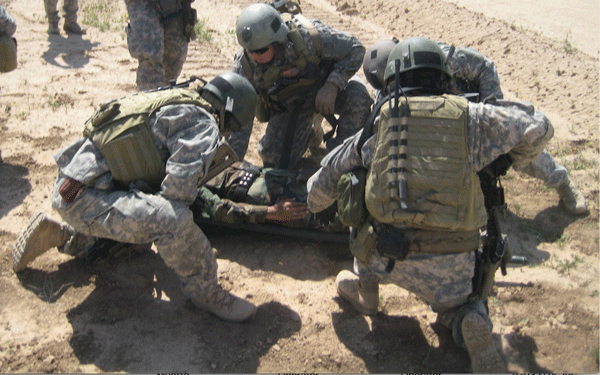Just before 9 pm on a warm July evening in Dallas, gunfire rang out during a protest. As civilians ran, the men and women of the Dallas Police Department ran into the fray. At the end of the night, 5 officers and 1 suspect were dead, and 9 people were wounded. How do we deliver good care in these dangerous places, when the highest level of medical care possible at the point of injury is paramount?
In Dallas, the Tactical Emergency Medicine Support (TEMS) physicians with the Dallas Police Department responded to the shooting. During this tense situation, they divided their resources, cared for people on the street and at the building where the suspect was barricaded — all the while surveying, triaging, and directing care to definitive treatment facilities. This is TEMS medicine.
TEMS physicians direct the performance of time-dependent interventions far within the outer perimeter established by law enforcement.
History
Battlefield medicine is as old as conflict itself. Over the past 20 years, however, military medicine has made leaps in developing enhanced techniques and an improved understanding of casualty management. In 1996, the first publication of trauma care guidelines for the battlefield outlined the concepts behind Tactical Combat Casualty Care (TCCC).1 Since then, Special Operations Medics have successfully implemented these strategies, which highlight the need for standardized approaches to trauma care, particularly for better hemorrhage control, airway management, and pneumothorax amelioration.2 The overall result of these improvements was a drop in significant fatalities in combat situations.
The concept behind TEMS stemmed from these military successes and was designed to fit the distinct needs of law enforcement personnel in high-risk tactical settings within the civilian world. TEMS personnel serve to administer this aid in dynamic environments where traditional civilian emergency medical services are inappropriate.
Current Models of Tactical Medical Care
In this emerging niche, several practice models are taking hold.
Dual Officer/Medic
The dual officer/tactical medical provider follows the precedent set by the military. Essentially, a health care provider that is of physical, intellectual, and tactical competence is cross-trained into the realm of law enforcement and tactical operations. This role is found in a myriad of law enforcement agencies and can occur in 3 tiers3:
Tier 1
The first tier includes a law enforcement officer (LEO) who is trained in the basics of hemorrhage control, airway repositioning and clearing, and tourniquet placement.
Tier 2
The second tier comprises an LEO who is trained to the level of an EMT-Basic, EMT-Advanced, or Paramedic. This individual has the rights and responsibilities of an LEO, meaning they can carry a weapon, arrest a subject, and make lawful life and death decisions, but they also provide emergency prehospital care.
Tier 3
The third tier includes training and equipping a “SWATDoc,” or a physician who is closely integrated within the unit. These physicians take ownership of the team, know the medical problems of each officer, have a clear understanding of the risks and benefits of the overall tactical operation, and are present during training and pre/post-operation. They are even available to care for family members should the need arise. Some departments using this system include the Dallas Police Department, Los Angeles Police Department, New York Police Department, and the United States Secret Service.
Advanced Life Support Standby
In areas where having a medical provider attached directly to the team is not feasible, teams have resorted to having EMS nearby. The advantages are that no additional personnel training have to be met, and EMTs can bring more equipment to the scene. The downsides include a lack of familiarity with the team, a lack of awareness about the mission, an inherent delay of care, and availability of EMS units. In this model, LEOs are at the mercy of local EMS time constraints and financial needs.
Role of Emergency Physicians in TEMS
Physicians as part of TEMS programs are increasing in number as the benefits have become more apparent. Emergency medicine (EM) physicians are in a particular position to offer great expertise to the tactical unit when trained in tactical medicine. Within this model, TEMS physicians direct the performance of time-dependent interventions far within the outer perimeter established by law enforcement.
Groups such as the Committee for Tactical Emergency Casualty Care (C-TECC) and ACEP's Tactical Medicine Section are incorporating evidenced-based tactical medicine into established protocols and working to better define the physician role within TEMS.4 As EM physicians, there is a growing need for our expertise from the point of injury onwards.
We would encourage you to reach out to these groups if at all interested in developing ways to assist your community within this dynamic field.
About the Authors
Jonathan Hardy is beginning his fourth year of medical school at the University of North Texas Health Science Center. He is a firefighter/paramedic and former Special Forces Medical Sergeant (18D).
Faroukh Mehkri is beginning residency at the University of Connecticut – Hartford Hospital in July. He graduated from the University of North Texas Health Science Center and served as a Dallas Police Officer in the Strategic Deployment Bureau.
References
- Callaway DW. Tactical Emergency Tactical Emergency Medicine Medicine (TEMS). National Collegiate Emergency Medical Services Foundation, 2006 Annual Conference. https://www.ncemsf.org/about/conf2006/presentations/callaway%20-%20tactical%20ems.pdf. Accessed Jan. 30, 2017.
- Eastridge BJ, Mabry RL, Seguin P, et al. Death on the battlefield (2001-2011): implications for the future of combat care. J Trauma Acute Care Surg. 2012;73(6 Suppl 5):S431-437.
- Morrissey J. Tactical EMS: An overview. PoliceOne.com. https://www.policeone.com/police-products/tactical/tactical-medical/articles/6352966-Tactical-EMS-An-overview. Accessed Dec. 23, 2016.
- NAEMT. TCCC-MP Guidelines and Curriculum. http://www.naemt.org/education/TCCC/guidelines_curriculum. Accessed Jan. 30, 2017.



